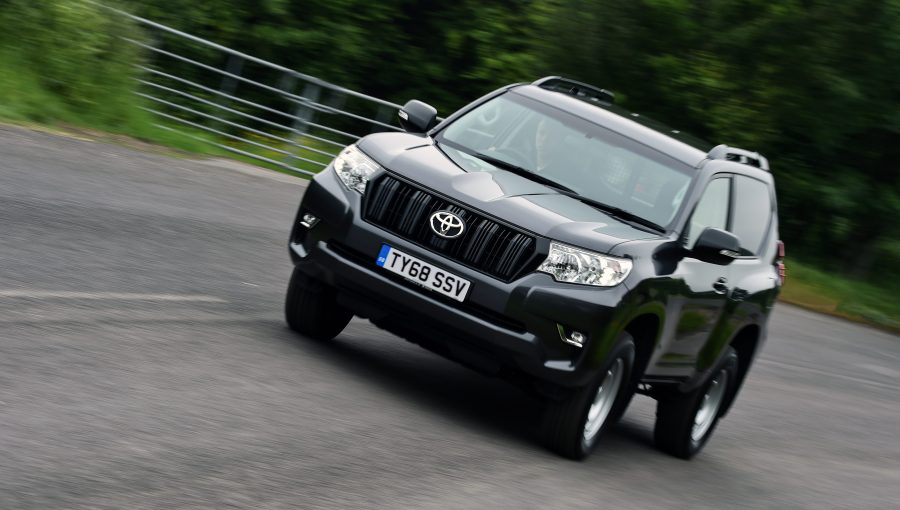Although Toyota’s passenger car range is predominantly focused around petrol-electric hybrid powertrains, the Land Cruiser, Hilux and Proace models are fitted with diesel engines. A diesel particulate filter (DPF) is a feature of these models, and you may have heard about the need for regular DPF regeneration. What does this component do and how do you take care of it?
What does a diesel particulate filter (DPF) do?
The DPF is fitted within the exhaust system and is designed to catch soot particles and nitrous oxide (NOx) from the combustion process that would otherwise be released into the atmosphere. The DPF is highly effective and traps around 80% of these harmful particulates.

Why do modern diesel engines need a DPF?
European legislation places strict exhaust emissions targets on all vehicle manufacturers. From September 2009, the Euro 5 legislative standard came into effect, part of which required all diesel cars registered from that point on to be equipped with a diesel particulate filter, or DPF.
These filters are used throughout the industry in all diesel-powered passenger vehicles, and their efficiency is vital now that stringent Euro 6d emissions standards are in force.
Do I need to replace a DPF during normal servicing?
Diesel particulate filters do have a capacity limit and can become full. But unlike traditional air, oil or pollen filters that need to be exchanged manually at regular intervals, the DPF has a much longer service life and is designed to regenerate to restore its performance.
The car’s electronic control unit (ECU) is programmed to do this automatically, neutralising the soot by burning it off at high temperature within the exhaust system while the vehicle is running. All modern cars with diesel engines follow this procedure.

How does DPF regeneration occur?
The regeneration occurs automatically, usually without the driver being aware that it is taking place. In the majority of cases, the process is carried out when the engine and exhaust system has reached normal operating temperature and the vehicle is travelling at over 40mph.
However, if your driving is limited to urban areas, the low speeds and frequent stops mean the conditions for normal regeneration do not exist. In these instances, the ECU monitors the accumulation of soot and instructs an alternative regeneration programme to begin well before the filter becomes saturated.
This programme injects small quantities of fuel into the engine after combustion, which increases the temperature within the exhaust system and creates an environment where it is possible to safely burn off the soot.
This method is very successful within the small percentage of vehicles where normal regeneration is not possible. However, due to the nature of city traffic, the regeneration process can be interrupted when the vehicle completes its short journey and is turned off. If this occurs, the ECU is programmed to recommence the process when the engine is restarted and back up to temperature again.

How can I help prevent DPF blockages in my Toyota?
Follow these four simple actions:
1. Regularly drive your Toyota on highways at speeds of between 40-55mph for around 20-30 minutes.
2. Avoid spending unnecessary amounts of time with the engine idling.
3, Try to limit the frequency of short journeys where the engine is running for less than ten minutes.
4. Do not ignore dashboard alerts related to the DPF.
Will I be warned if all DPF regeneration processes have been unsuccessful?
Very occasionally, use of the vehicle might be such that it will have been impossible for the ECU to complete the administration of any regeneration procedure. At this point, the DPF will have become overloaded and stopped functioning, so your Toyota will illuminate a warning light in the dashboard. It will then be necessary for the soot to be neutralised and the filter regenerated manually at a main dealer.
It is extremely unwise to ignore this visual warning as the DPF can become irreparably damaged. What’s more, it is illegal to remove the filter entirely.
Learn more: What is the exhaust gas recirculation valve and what does it do?





Hello.
I have Toyota yaris 2010 1.4 d4d with reg: GV60EWY .
My engine error light is on with code P2463 and I couldn’t find any reason of that(There is not any description of this code)? Is it possible that on because of DPF or is something else? Would you please let me know what is that error code and what should I do? There is not any black smoke in my car just I am feeling a bit reduction in my car acceleration .
Many thanks
Hi Arash,
Thanks for getting in touch. The diagnostic Trouble Code (DTC) ‘P2463’ means that the Diesel Particulate Filter (DPF) is restricted due to soot accumulation.
Modern diesel vehicles fitted with a DPF, need the exhaust to get up to temperature in order to burn away/clear the soot that accumulates. It is therefore recommended that the vehicle is driven at motorway speeds for a time that allows the exhaust to get hot and then burn away the soot that has accumulated.
If the vehicle rarely covers long journeys, not allowing the exhaust to get up to temperature, soot will inevitably accumulate in the DPF and giving the symptoms that you are experiencing.
We would therefore recommend that you take the vehicle on a motorway journey allowing the exhaust to get hot (20 mins or more for example), then see if the warning message clears. If the message still fails to clear, your local Toyota Centre may be able to carry out a forced regeneration or investigate further if the DPF remains blocked. Hope this helps.
I had this issue continually. With contaminated engine oil as the diezel couldn’t burn of in the dpf. My issue was a faulry air/fuel sensor causing the system to run rich and soot up the filter all the time
Thanks for your response.
I bought DPF cleanear which spray inside car DPF system from temperature sensor.
I wish that job can help to clear my DPF.😔
Unfortunately if I request to dealer for this job , it should be cost me too much.
I have a Toyota Auris I had the Dog cleaned last May today engine light warning triangle came on and the car lost power anything I can do
Hi Robin,
Thanks for getting in touch. I’m sorry to hear about the issue with your car. Please contact your local Toyota dealers so they can inspect it. You can find them here: https://www.toyota.co.uk/find-your-dealer.json
I own an Auris 1.4D-90 and had the same problem, workshops, generally reccomends manual cleaning but in my opinion they miss the point and the problems will recurr in less than 10 days.
Workshops should initiate a manual regeneration and the owner must run the car approx. 30 min. at a speed greater than 70 km/hr., the DPF will clean and the consumption will drop significantly, i.e. in my car the consumption drop from 6 lt. to 5.5 lt/100 km.
The cost of initiating a manual regeneration is nothing, only connect the engine scanner and activate it, probably, this is the reason why they prefer a manual cleaning and charge 250 euro for the operation.
I was devastated the other day to have the engine warning light come on on my 2010 Yaris D4D.
I had just driven it from Annecy in France to Oxford in the UK, and then back again. These are two journeys of 1100km each way. I used motorways for the whole journey (120kmph in the UK and 130kmph in France) so there was plenty of opportunity for the DPF to clean itself several times over. I am therefore very suspicious of the glib suggestions we get from the Toyota garages and even from Toyota Europe that these DPFs clog up because of too much city driving or journeys of too short a distance. My Yaris has never been driven like that, so I’ll need a more understanding reply from the powers that be.
Hi Roger,
Thank you for contacting us. The DPF is a filter and eventually, will get clogged up so much that it is beyond cleaning and will need to be replaced. With regards to the motorway driving it is the engine speed that is important not necessarily road speed. Please could you send us your reg and/or vin details so we can look in to your case further. Many thanks.
Hi
Thanks for offering to look into this for me.
The vehicle has been driven less than 25,000 km in total, and only ever on medium or long distance rural journeys, mostly on motorways.
The VIN is VNKKC96320A228363.
Regards
Roger
Hi Roger,
We’ve looked into your vehicles history and it appears that all the servicing and the warranty has been done in France, so Toyota UK don’t have access to all the information. From what you have told us, your car has done less than 25000 km and is 8 years old, that’s only 3,000 km a year which is not a normal drive pattern for a DPF vehicle. We’d recommend replacing your DPF filter at your local Toyota dealer. You can find you local dealer here: https://www.toyota.co.uk/find-your-dealer.json. Hope this helps.
25000 km in 8 years is indeed around 3000 km per year. However, all of that driving has been on open roads or motorways, and almost no journeys have been shorter than 10 km. Typically they are 100 km or more (sometimes 1100 km, as mentioned in my earlier post).
Toyota’s DPFs are not smart enough to know anything about annual mileage, so what aspect of a 3000 km per year, open road, 10 km minimum journey driving pattern is the DPF struggling with? Surely it’s a simple as “I need a clean, I am up to temperature, I’m driving more than 40mph, so I can clean myself”.
Is Toyota going to replace my DPF as one of the many recalls I’ve had for this car to date (turbo, airbags, brakes, various switches, etc.), because it is clearly not up to the job. Hopefully the replacement DPF will be a whole lot better than the original one, because I don’t plan on increasing my annual mileage just so I don’t have to replace a DPF every 8 years … especially one that is clearly not designed for infrequent open road driving.
Toyota has been fantastic with all of the other product recalls. I’m struggling to understand why these sub-optimal DPFs are not being treated like the rest of the product recalls. Maybe they don’t need a blanket recall, but they should at least be replaced free of charge when they fail due to no fault of the driver.
Hi Roger,
We’re sorry you feel this way. If you’d like to take this any further, we’d suggest contacting our Customer Relations team. You can find their details here: https://www.toyota.co.uk/contact-us/index.json.
My 2006 RAV4 D-CAT has become sluggish in the past 3 weeks. it’s unable to pick up speed quick enough as before. The OBDII scan tool says P0200 (Injector Circuit Open) but the technician says it’s a DPF issue. I’m tempted to believe him because a check last year gave the code P2002 (Diesel Particulate Filter Efficiency below Threshold). But this has since cleared and never came again. In fact, I do not often use this car but once in about 2 months, I do give it a blast on the highway for about an hour and half doing about 120kmph. So, what is the cause of the current sluggishness and the often regeneration?
Hi,
Unfortunately it is impossible to diagnose this without inspecting the vehicle. Please contact your local Toyota dealer for assistance. If they are unable to help, we can only recommend contacting customer services in your region. Thanks.
Does the fuel level affect dpf regeneration? I read somewhere that it doesn’t work if less a 1/4 full. I’ m having problem of diesel raising the oil level. Why/how does this happen?
Hi Eamonn,
Thank you for getting in touch. We’d have to recommend speaking with your local Toyota Centre to get a diagnosis and explanation. The technicians will be able to explain in depth and answer any questions you may have. We hope this helps and your questions get resolved soon. Many thanks.
Hi – DPF clogged up – apparently 95% full – this led to various problems – high oil level, spanner light kept coming on, was juddering etc when idle. The Toyota garage said I was using the vehicle incorrectly. During the week I do short journeys then at the weekend it normally gets 3-4 decent 40 minute journeys doing 50-60mph. Once a month it gets a decent motorway run.
Apparently to stop it happening again I need to do 50mph in 4th gear keeping the revs over 3000 for 30 – 40 minutes with no stops or slowing – at least once per week? Does this seem right?
How am I meant to do this? There are not many roads in the UK where you can do it and apparently motorway driving is not suitable as the revs are not high enough. Also if you stop at any point you lose the benefit and have to start over again – that means not traffic lights etc.
Can someone please explain how I am meant to do this.
Also why did they call it an ‘Urban Cruiser’ when it is not designed for urban driving??
thanks
Hi Marlon,
Thank you for your comment. After speaking to our Technical team, they say that the 30 – 40 minute drive with no stops is not correct. However, in order to give you a more detailed answer, please could you provide your reg or VIN number. Many thanks.
Hi – my Reg is MV10 SZP. I think it would be very helpful for me and the rest of the people reading this if we had the exact official details on how we avoid the DPF clogging up when you tend to do short journeys and urban driving.
Hi Marlon,
There are so many factors that can affect the DPF and it would be impossible to say at this stage. We’d strongly advise taking it to a Toyota Centre for full evaluation and diagnosis. You can find your local dealer here: https://www.toyota.co.uk/find-your-dealer.json.
There is currently nothing wrong with the DPF. I just need to know what is the general guidance for stopping it clogging up and making sure it does the regen – on this model. There seems to be different advice from different people. Toyota must have some centralised information and advice on how you are meant to drive the car to avoid it?
Hi Marlon,
Our Technical team would advise driving the car normally and if the system cannot re-gen with that drive style, it will give a warning indicator. If this warning indicator comes on, it has tried to re-gen but cannot and you need to drive it normally, but hold the revs slightly higher or select a lower gear than normal for a short time, 5-15mins.
It is also very important to use good quality Diesel and not super market fuel. Also the correct oil should be used, specs for each car can be found in the owner’s manual.
Hope this helps.
I was take my car 100 time and all the time said there is nothing rungs to the car and dpf is not on warranty we can not do any thing also I spent over 2000£ to sort out the problem but still bad and smoke all the time
I have a 2010 Toyota Yaris 1.4 D4D. A couple of months ago DPF was blocked and engine management light came on. I bought a Toyota DPF filter (£400+) and installed onto car garage ( further £250). Engine management light still came on and was told to take to Toyota dealer. I took the car to Toyota dealer who said DPF was blocked and they did a forced regeneration to clear the DPF. I asked how the DPF could be blocked when it is brand new and had only done 50 miles between the installation and going to the dealer. Couldn’t give me an answer. Anyway, had had had enough by this stage and thought well it is working now, hopefully no more issues with it. How wrong was I. Approximately 4 weeks later the engine management light has come on again so I will have to book into dealer again! and get some truth about this matter. How can a brand new DPF become blocked again after 4 weeks? I at the very least will be seeking a refund from Toyota for shelling out on a new DPF that suddenly becomes blocked almost immediately. I feel Toyota are not dealing at all effectively with the issue of blocked DPF filters. I know the answer I will get…. contact your local Toyota dealer for help! Well so far they have been utterly hopeless.
Following on from my comment above I took Yaris to the dealer today and they have no clue as to why DPF comes up on diagnostic as full. They have asked me to bring the car in again on Thursday so they can have more time to find what is at fault. Well my request to you Toyota GB is to contact this Toyota dealer (Corrie Motors, Inverness tel.no 01463 226000) and diagnose this problem asap. Will you??????
I had the same problem last year. Got 40k miles from original filter with no problem then needed many regenerations until it was every 100 miles. Put a new one in and thought, should get 40k trouble free. Within a few thousand mikes it was doing it again. Why Toyota? We never get an answer, it must be sensor related faulty readings but they won’t admit to it because it will cost them money. I bet we don’t get an answer. I had to change to a petrol engine to cure mine.
Why is my question from Friday not showing?
Hi Marlon,
We’re looking into this for you. All comments go through an approval process and we’re waiting to hear back from our technical help team. Once we hear back from them, we will reply to your previous comment. Many thanks.
Hi Lee,
Thank you for your comments. We recommend you follow the advise provided by your Toyota Centre to resolve the issue. Many thanks.
My Yaris has been with a Toyota linked garage for a week now. We took it in as the engine management light came on. The garage are telling me that they are 30% of the way through the checks to find out what is wrong with the car. Every time they get an error code they have to email it to Toyota to get a response and then move on to the next code. I just don’t understand how this process can take so long. We’ve had problems with the dpf before and the dpf light was on just before the engine management light came on. The garage say that there is no way they can speed up this process as Toyota reply ‘when they feel like it’.
It’s such poor customer service.
Hi Susan,
Thank you for contacting us. We’re sorry to hear about your experience, please could you direct message us on either Facebook or Twitter with your name, email address and let us know the issues you are facing. This will enable us to set up a case for you in order to speed up this process. You can find our social media pages here: https://www.facebook.com/toyotauk, https://twitter.com/ToyotaGB.
Hope this helps.